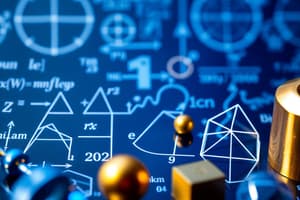Podcast
Questions and Answers
What is the study of the collection, analysis, interpretation, presentation, and organization of data called?
What is the study of the collection, analysis, interpretation, presentation, and organization of data called?
- Algebra
- Statistics (correct)
- Geometry
- Calculus
Which area of mathematics deals with the properties of points, lines, surfaces, and solids?
Which area of mathematics deals with the properties of points, lines, surfaces, and solids?
- Algebra
- Calculus
- Statistics
- Geometry (correct)
What do mathematicians use to establish mathematical truths?
What do mathematicians use to establish mathematical truths?
- Guesswork
- Approximation
- Rigorous deduction (correct)
- Estimation
What is the study of numbers and their properties, along with basic operations, known as?
What is the study of numbers and their properties, along with basic operations, known as?
Which branch of mathematics studies relationships between the angles and sides of triangles?
Which branch of mathematics studies relationships between the angles and sides of triangles?
What is the name of mathematical statements that show the equality of two expressions?
What is the name of mathematical statements that show the equality of two expressions?
What field of mathematics focuses on continuous change, including rates of change and accumulation?
What field of mathematics focuses on continuous change, including rates of change and accumulation?
What type of reasoning involves going from specific observations to general principles?
What type of reasoning involves going from specific observations to general principles?
Which of the following is a set of numbers that can be expressed as a fraction?
Which of the following is a set of numbers that can be expressed as a fraction?
What is the name for symbols that represent unknown values?
What is the name for symbols that represent unknown values?
Flashcards
What is Mathematics?
What is Mathematics?
The science and study of quantity, structure, space, and change.
Arithmetic
Arithmetic
Studies numbers and their basic operations (addition, subtraction, multiplication, division).
Algebra
Algebra
Deals with symbols and the rules for manipulating them.
Geometry
Geometry
Signup and view all the flashcards
Trigonometry
Trigonometry
Signup and view all the flashcards
Calculus
Calculus
Signup and view all the flashcards
Statistics
Statistics
Signup and view all the flashcards
Theorems
Theorems
Signup and view all the flashcards
Proofs
Proofs
Signup and view all the flashcards
Fundamental Theorem of Arithmetic
Fundamental Theorem of Arithmetic
Signup and view all the flashcards
Study Notes
- Math encompasses the science and study of quantity, structure, space, and change
- Mathematicians identify patterns, create conjectures, and use axioms and definitions to establish truths through rigorous deduction
- Math provides essential tools applicable worldwide across natural science, engineering, medicine, finance, and social sciences
- Applied mathematics utilizes mathematical tools to address practical problems in natural science, engineering, medicine, finance, and social sciences
Areas of mathematics
- Arithmetic studies numbers, their properties, and basic operations such as addition, subtraction, multiplication, and division
- Algebra involves mathematical symbols and the rules that govern their manipulation
- Geometry examines the properties and relationships of points, lines, surfaces, solids, and their higher-dimensional counterparts
- Trigonometry focuses on the relationships between angles and sides of triangles
- Calculus explores continuous change, including rates of change and the accumulation of quantities
- Statistics includes the collection, analysis, interpretation, presentation, and organization of data
- Logic is the study of valid reasoning, argumentation, consistency, non-contradiction, and truth
- Number Theory studies the properties and relationships of numbers, especially integers
- Topology studies geometric properties that remain unchanged under continuous deformations like stretching, twisting, crumpling, and bending, excluding tearing or gluing
- Discrete Mathematics studies mathematical structures that are fundamentally discrete rather than continuous
- Set Theory studies sets as abstract collections of objects
Basic Mathematical Concepts
- Numbers are used for counting, measuring, and labeling
- Natural numbers include 1, 2, 3, and so on
- Integers include ..., -2, -1, 0, 1, 2, and so on
- Rational numbers can be expressed as fractions
- Real numbers include both rational and irrational numbers
- Complex numbers consist of real and imaginary parts
- Variables are symbols representing unknown or changing quantities
- Equations are mathematical statements asserting the equality of two expressions
- Functions represent relationships where each input corresponds to a unique output
- Operations refer to processes like addition, subtraction, multiplication, and division
- Theorems are statements proven true based on axioms and prior theorems
- Proofs demonstrate the truth of a theorem through logical arguments
Fundamental Theorems
- Pythagorean Theorem defines the relationship between the sides of a right triangle
- Fundamental Theorem of Arithmetic states that every integer greater than 1 can be uniquely expressed as a product of prime numbers
- Fundamental Theorem of Calculus connects differentiation and integration
Mathematical Notation
- Mathematical symbols include +, -, ×, ÷, =, <, >, ≤, ≥, etc
- Greek letters represent angles, constants, and variables
- Examples of functions are f(x) and g(x)
- Derivatives are expressed as dy/dx and f'(x)
- Integrals are written as ∫f(x) dx
- Limits are expressed as lim (x→a) f(x)
- Summations are denoted by Σ
Mathematical Reasoning
- Deduction involves reasoning from general principles to specific conclusions
- Induction involves reasoning from specific observations to general principles
- Proof by contradiction involves assuming the opposite of what is to be proven, leading to a contradiction
Applications
- Physics utilizes math to model and understand the physical world
- Engineering uses math to design and construct structures, machines, and systems
- Computer science relies on math for computer algorithms and data structures
- Economics uses math to model economic systems and make predictions
- Finance applies math to manage risk and make investment decisions
History of Math
- Ancient civilizations like the Egyptians and Babylonians developed practical math for surveying, construction, and astronomy
- Greek mathematicians such as Thales, Pythagoras, Euclid, and Archimedes significantly contributed to geometry and number theory
- During the Medieval period, the Hindu-Arabic numeral system was adopted, and algebra was further developed
- The Renaissance saw the development of calculus and analytic geometry
- Modern math includes the development of set theory, topology, and other advanced concepts
Mathematical Skills
- Problem-solving involves analyzing problems, developing strategies, and finding solutions
- Logical reasoning includes the abilities to think critically and construct valid arguments
- Abstract thinking is the ability to understand and manipulate abstract concepts and symbols
- Computational skills include performing mathematical operations accurately and efficiently
Branches of Applied Mathematics
- Numerical Analysis focuses on creating and studying algorithms to solve mathematical problems numerically
- Optimization involves finding the best solution to a problem with specific constraints
- Mathematical Modeling creates mathematical representations of real-world situations
- Financial Mathematics uses math techniques in financial markets and risk management
- Actuarial Science employs mathematical and statistical techniques to assess risks in insurance and finance
Studying That Suits You
Use AI to generate personalized quizzes and flashcards to suit your learning preferences.




